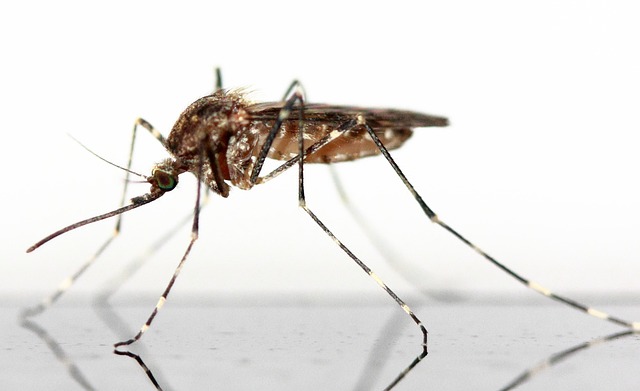In today's world, balancing human comfort and environmental preservation is crucial in commercial mosquito control. Traditional chemical sprays are effective but carry health and ecological risks. As a result, there's a growing emphasis on eco-friendly Integrated Pest Management (IPM) strategies, including biological control, habitat manipulation, and repellents. Shifting away from synthetic chemicals, urban settings can adopt green practices like leveraging natural predators, creating habitats that discourage mosquitoes, using plants with insecticidal properties, strategic landscape design, physical barriers, and regular removal of standing water. Measuring success through regular evaluations ensures these methods are both sustainable and effective, reducing mosquito populations and associated health risks while maintaining public health standards.
In the quest for effective yet sustainable mosquito management, we explore eco-friendly solutions tailored for urban environments. Commercial mosquito control, a vital public health measure, often relies on chemical treatments with potential environmental impacts. This article delves into alternative strategies that balance pest control and ecological preservation. We examine the current landscape of commercial mosquito control, uncover promising green practices, and discuss methods to measure the success of these eco-based interventions.
Understanding Commercial Mosquito Control: The Current Landscape
In today’s world, understanding commercial mosquito control is paramount as we navigate the delicate balance between human comfort and environmental preservation. The current landscape of mosquito management in urban settings is dominated by chemical-based solutions, which, while effective, come with potential health and ecological risks. These traditional methods involve spraying pesticides, often during specific times of day or night, to target adult mosquitoes resting on water surfaces or in vegetation. However, these chemicals can have adverse effects on non-target organisms, including beneficial insects, birds, and aquatic life.
The push for more eco-friendly solutions has led to a growing emphasis on integrated pest management (IPM) strategies. IPM involves a combination of methods—including biological control, habitat manipulation, and the use of repellents—to manage mosquito populations sustainably. By adopting these approaches, commercial properties can effectively reduce mosquito habitats and protect public health without resorting to widespread chemical applications. This shift towards more environmentally conscious practices is not just a trend but a necessary step towards a healthier and more balanced ecosystem.
Eco-Friendly Solutions for Mosquito Management
In today’s world, where environmental consciousness is on the rise, it’s crucial to shift away from traditional, chemical-laden commercial mosquito control methods. Eco-friendly solutions offer a sustainable and safe alternative for managing mosquito populations. One such approach involves the strategic use of natural predators like birds and bats, which are known to feast on mosquitoes. Encouraging these beneficial insects through habitat creation can significantly reduce mosquito numbers in outdoor spaces.
Another effective eco-friendly strategy is implementing biological controls. This includes introducing bacteria like Bacillus thuringiensis israelensis (Bti), a soil-borne bacteria that specifically targets mosquito larvae. Bti is non-toxic to humans and pets, making it a safe and environmentally friendly option for commercial mosquito control. Additionally, using plants with natural insecticidal properties, such as citronella, lavender, and marigolds, can act as natural repellents, creating a harmonious and mosquito-free environment without harmful chemicals.
Implementing Green Practices in Urban Environments
In urban environments, implementing green practices offers a sustainable and eco-friendly approach to commercial mosquito control. This strategy focuses on minimizing the use of synthetic chemicals by leveraging natural methods and habitat manipulation. For instance, introducing beneficial insects like dragonflies and damselflies can help control mosquito populations as these predators feed on larvae and adults alike. Additionally, proper landscape design, including water features and native plant species, creates an environment that discourages mosquitoes while fostering biodiversity.
Urban planners and property managers can also employ physical barriers such as screens and netting in outdoor spaces to prevent mosquito entry. Maintaining clean water sources by regularly emptying standing water from containers like buckets, pots, and discarded tires is another effective measure. These green practices not only reduce environmental impact but also contribute to a healthier urban ecosystem, ensuring a balanced approach to mosquito management that benefits both humans and the natural world.
Measuring Success: Monitoring and Evaluating Eco-Based Strategies
Measuring Success is a crucial step in adopting eco-friendly strategies for mosquito management, especially in urban areas where commercial mosquito control methods have traditionally dominated. Evaluating the effectiveness and impact of these new approaches ensures that efforts are not only environmentally sustainable but also achieve their intended goal of reducing mosquito populations and associated health risks. Monitoring involves tracking key indicators such as mosquito abundance, distribution, and species composition before, during, and after implementing eco-based solutions. This data-driven approach allows for the identification of successful tactics and those needing adjustment.
Regular assessments enable experts to understand how these strategies influence local ecosystems, ensuring minimal ecological disruption while maintaining or improving public health standards. By comparing results with traditional commercial mosquito control methods, researchers can demonstrate the long-term viability and benefits of eco-friendly alternatives, fostering wider adoption and encouraging further innovation in sustainable pest management practices.
As we’ve explored, the traditional methods of commercial mosquito control often rely on harmful chemicals. However, with growing environmental concerns, there’s a pressing need for eco-friendly solutions. This article has highlighted various green practices and strategies that offer effective yet sustainable ways to manage mosquito populations. By adopting these eco-conscious approaches in urban environments, we can achieve a balance between public health protection and preserving the ecosystem. Implementing and monitoring these strategies will contribute to a safer, healthier, and more environmentally balanced future for our cities.
